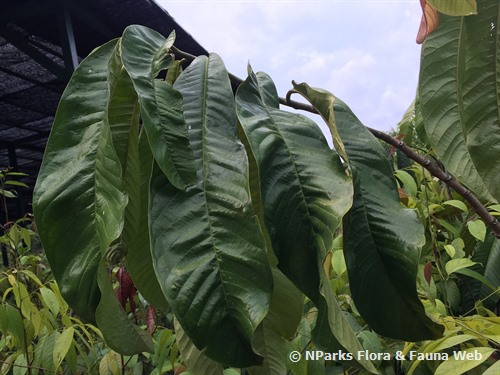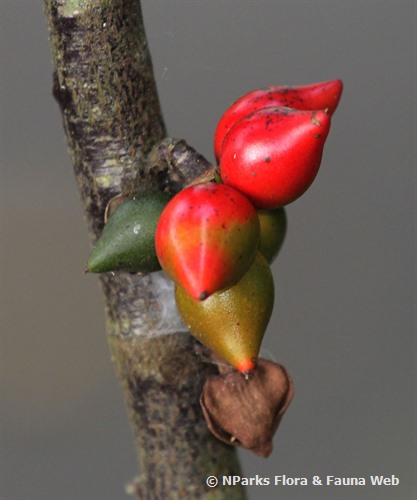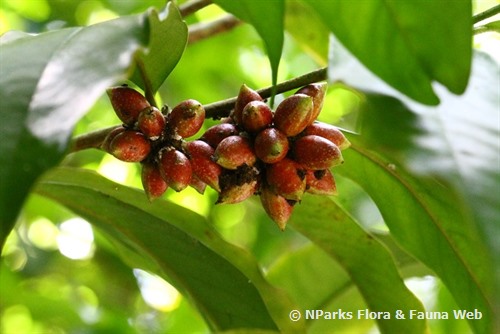.jpg)
Name
Classifications and Characteristics
| Plant Division | Angiosperms (Flowering Seed Plants) |
|---|---|
| Plant Growth Form | Shrub |
| Maximum Height | 5 m |
Biogeography
| Native Distribution | Thailand, Sumatra, Peninsular Malaysia, Singapore, Borneo, and Java |
|---|---|
| Native Habitat | Terrestrial |
| Preferred Climate Zone | Tropical |
| Local Conservation Status | Native to Singapore (Endangered (EN)) |
Description and Ethnobotany
| Growth Form | It is a shrub up to 5 m tall. |
|---|---|
| Foliage | Its alternate, stalked leaves have leathery blades that are usually oblong to lance-shaped, and 22–30 by 6–11 cm. Its leaf blade midrib is protruding below. |
| Flowers | Its flowers grow singly on the older branches, are fragrant, and have petals that are whitish. Its outer petals are lance-shaped-oblong, and 3.3 cm long, while inner petals are about 1.8 cm long. |
| Fruit | The fruits are red, stalkless, round-egg-shaped, thin-walled, and 1–2 by 1 cm. Each fruit contains 1 pale brown seed. |
| Habitat | It grows in inland forest from 50–1500 m altitude. It occurs locally in Nee Soon Swamp Forest, Mandai Forest, and in the vicinity of MacRitchie Reservoir. |
| Associated Fauna | Its flowers are insect-pollinated. |
| Etymology | Greek Goniothalamus, referring to the angular fruiting body; Greek macrophyllus, with large leaves, referring to the leaves of this species |
| Ethnobotanical Uses | Others: In Java, mountain dwellers use an infusion of the roots to treat typhoid fevers. Its smoke can also be used to repel mosquitos, snakes and other wild animals. |
Landscaping Features
| Desirable Plant Features | Ornamental Flowers |
|---|---|
| Landscape Uses | Parks & Gardens |
Fauna, Pollination and Dispersal
| Pollination Method(s) | Biotic (Fauna) |
|---|
Plant Care and Propagation
| Light Preference | Full Sun, Semi-Shade |
|---|---|
| Water Preference | Moderate Water |
Image Repository
Others
| Master ID | 31017 |
|---|---|
| Species ID | 5404 |
| Flora Disclaimer | The information in this website has been compiled from reliable sources, such as reference works on medicinal plants. It is not a substitute for medical advice or treatment and NParks does not purport to provide any medical advice. Readers should always consult his/her physician before using or consuming a plant for medicinal purposes. |



.jpg)

_lowres.jpg)